GA4GH Beacon project¶
Technical Documentation
This website provides some general information about the GA4GH Beacon protocol. Please visit docs.geneomebeacons.org for technical and implementation details.
![]()
A schematic representation of how Beacon works. (A) Beacon API implementation and (B) A Beacon query and aggregated response¶
One of the main bottlenecks in human genomics research is lack of data. A Beacon is a genomics discovery tool which allows to aggregate worldwide genomics dataset through a shared query protocol.
In order to promote personalised medicine, inclusive diagnostics, prognostic and therapeutic strategies, we cannot afford to keep the data completely "locked in". The Beacon API aims to solve this problem by enabling the search of genomic variants and associated information without jeopardising the privacy of the dataset. Any hospital or research entity can choose to 'beaconize' their omics dataset without compromising the privacy or the ownership of the dataset, thus helping the worldwide community of researchers and assisting science through the power of data.
The Beacon Project is developed under a Global Alliance for Genomics and Health (GA4GH) Initiative for the federated discovery of genomic data in biomedical research and clinical applications.
What is the Beacon Standard?¶
The Beacon protocol defines the programming interface ("API") for implementing individual beacon resources. A beacon resource uses the Beacon API usually extended with a that allows for data discovery of genomic and phenoclinic data. Originally, the Beacon protocol (versions 0 and 1) was limited to information about the presence/absence of a given, specific, genomic mutation in a set of data, from patients of a given disease or the population in general. The version 2 (v2) of the Beacon protocol has been accepted as GA4GH standard in Spring 2022 and includes, among other changes:
- Query options for biological or technical "meta"data using filters defined through CURIEs (e.g. phenotypes, disease codes, sex or age).
- An option to trigger the next step in the data access process (e.g. who to contact or which are the data use conditions).
- An option to jump to another system where the data could be accessed (e.g. if the Beacon is for internal use of the hospital, to provide the Id of the EHR of the patients having the mutation of interest).
- Annotations about the variants found, among which the expert/clinician conclusion about the pathogenicity of a given mutation in a given individual or its role in producing a given phenotype.
- Information about cohorts.
Move to Beacon v2
With the release of Beacon v2 implementations of v1 and earlier are not longer supported. Deployers of Beacon instances or networks are advised to migrate to v2 of the standard. The functionality of Beacon v1 can be easily implemented in v2.
![]()
Progenetix - Example of a Beacon Implementation for Data Delivery in Oncogenomics
The Progenetix oncogenomic website is built on top of a Beacon v2 implementation. It provides an example for a data-rich resource and demonstrates Beacon queries beyond allele discovery, with a focus on structural genome variations. More information can be found at the Progenetix documentation and on its search page.
Schematic example of a Beacon query¶
Beacon v2 technology¶
The Beacon v2 is based on a two-part concept:
In principle, this concept allows for different Models (in other domains outside of the Beacon v2 realm, e.g. “Imaging Beacon”) to be built using the same Framework. However, in the current context of Beacon v2, we consider the two elements interdependent and likely to be updated together for subsequent major versions.
For further information please refer to the Beacon v2 documentation.
Beacon and Security¶
Genomics data in principle may allow the re-identification of individuals in genomics data repositories which leads to a generally high level of protective measure being applied to such data. However, with the right choice of data sharing protocols, data security infrastructure and good health data practices, the sharing and discovery of genomics and related data can be possible and enable valuable insights into disease related as well as prognostic and lifestyle related genomic variations.
Acknowledgements¶
Beacon partners¶
In 2020, the GA4GH Beacon group started a set of meetings and interviews with GA4GH Driver Projects and with ELIXIR partners in order to determine the scope of the next generation Beacon. The goal was to be useful without breaking the simplicity that made Beacon version 1 successful.
Interviews were conducted with the following GA4GH Driver Projects:
- Autism Speaks
- BRCA Exchange
- CanDIG
- European Genome-phenome Archive, European Nucleotide Archive, European Vegetation Archive
- EuCanCancer
- European Joint Programme - Rare Diseases
- H3Africa
- GEM Japan
- Genomics England
- Matchmaker Exchange
- VICC
Some ELIXIR partners were also interviewed, i.e. Café Variome, FPS, RD-Connect, CINECA, and Disgenet. Among ELIXIR Spain TransBioNet and Bioinformatics in Barcelona members, a set of Catalan hospitals (e.g. Hospital Clinic) are exploring how to use Beacons inside their genomic diagnose teams and how to share the diagnoses between hospitals.
Beacon early implementers¶
At the time of submission at the end of 2021, five Beacons were already implemented in a Beacon Service Registry. The "early implementers" actively participated in refining the Framework as they were responsible for spotting any issue they might encounter with the Framework or Model.
- European Genome-Phenome Archive EGA Beacon
- Progenetix' Beacon+
- Cafe Variome
- Fundación Progreso y Salud's Beacon v2 API
- CNAG's Beacon v2 API
Beacon News, Events and Publications¶
Implementing the GA4GH Beacon API for Genomic Discovery and Sharing in an Open Data Paradigm
Poster at GA4GH 2025 Plenary
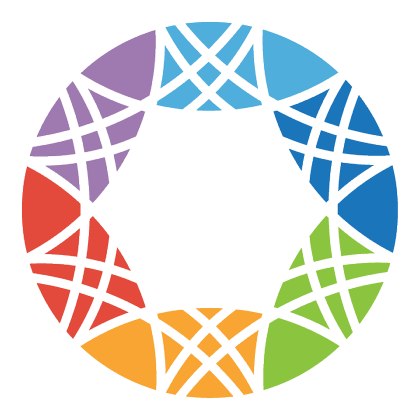
Abstract Besides the discovery of genomic and pheno-clinic data in different access settings, the GA4GH Beacon protocol also enables the retrieval of matched records through a variety of open or protected mechanisms, depending on the resources’ data structure as well as data protection and regulatory requirements. While data discovery scenarios with limited and/or aggregated responses will constitute a large fraction of Beacon and Beacon Network scenarios, the protocol also empowers the sharing of data e.g. in open research data settings.
Since 2016 the Progenetix cancer genomics reference resource has served as a platform for the implementation driven development and testing of the Beacon protocol. Continue reading
pgxRpi: an R/Bioconductor package for user-friendly access to the Beacon API
Hangjia Zhao and Michael Baudis¶
Bioinform Adv. 2025 Jul 16;5(1):vbaf172¶
- doi: 10.1093/bioadv/vbaf172
- PMID: 40761325
Abstract: The Beacon specification, established by the Global Alliance for Genomics and Health (GA4GH), consists of a standardized framework and data models for genomic and phenotypic data discovery. By enabling secure, federated data sharing, it fosters interoperability across genomic resources. Progenetix, a reference implementation of Beacon, exemplifies its potential for large-scale genomic data integration, offering open access to genomic mutation data across diverse cancer types. Here we present pgxRpi, an open-source R/Bioconductor package that provides a streamlined interface to the Progenetix Beacon REST API, Continue reading
Double Feature: Beacon Version 2.1.2 and 2.2.0 Released
Concurrent releases of Beacon Standard 2.1.2 and 2.2.0
On July 1st we released two updated versions of the Beacon standard, to allow developers differential updates. Please see the list of changes:
Continue readingGA4GH Connect April 2025 in Cambridge MA
Spring 2025 GA4GH Connect working meeting
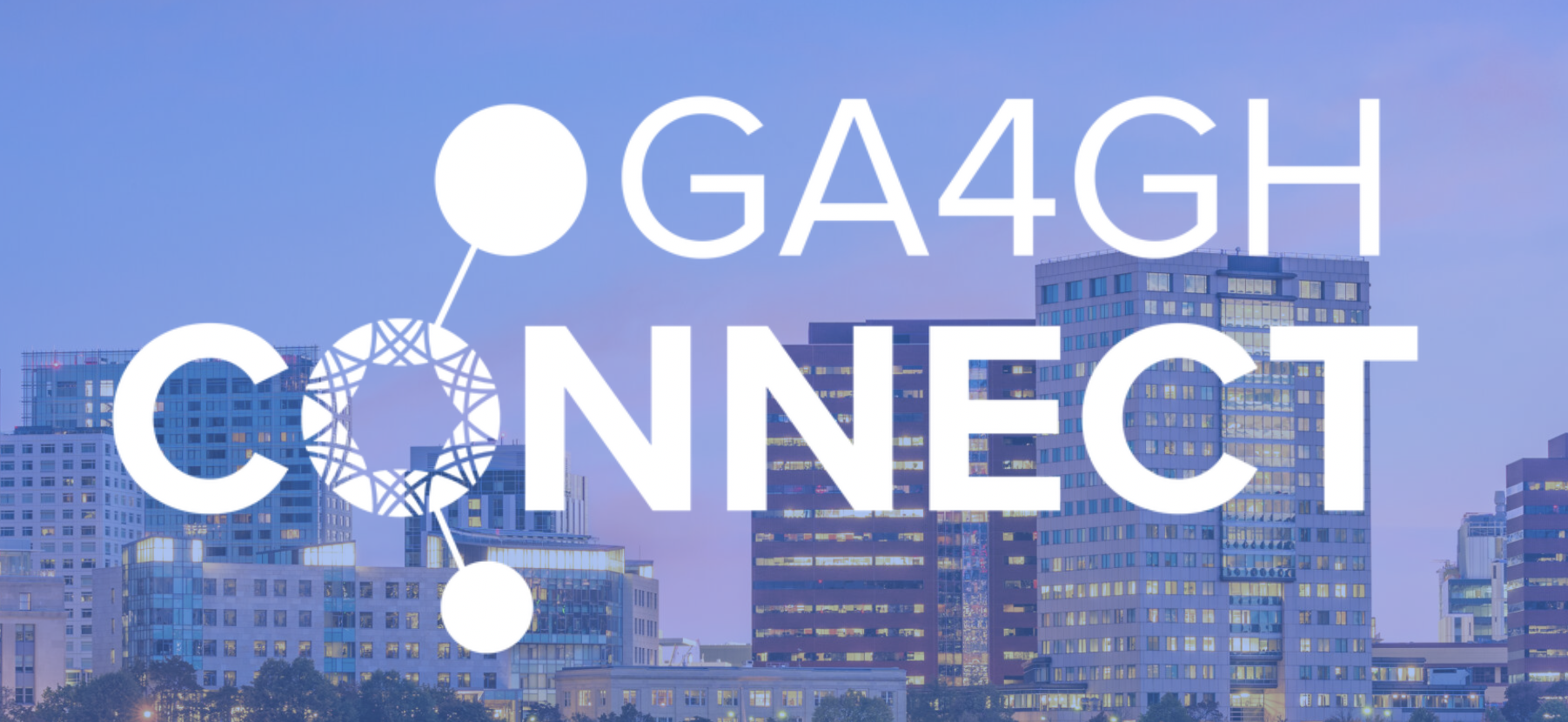
The GA4GH Connect meeting provides an opportunity for contributors to advance the GA4GH Road Map and gather feedback on product development and needs. Members of the GA4GH community are invited to this year's Connect meeting in Cambridge, USA. Throughout the meeting there will be several sessions focussed on or involving Beacon related topics.
Continue readingData Discovery in Biomedical Genomics and Cancer Research - Implementing a New Paradigm
2nd Thailand Bioinformatics Research Network (TBRN) Conference

The past few decades have highlighted the need for large-scale approaches to data analysis in both rare disease genetics and cancer genomics due to the vast diversity of genomic variations. While individual and collaborative studies have advanced research, addressing the different levels of genomic diversity requires both data curation and the integration of disparate genomic resources.
In this presentation Michael introduces some concepts and examples of genomic data repositories and explain how our work on the Progenetix oncogenomics resource aligns with standards development for the Global Alliance for Genomics and Health, particularly the GA4GH Beacon API.
Continue readingBeacon Version 2.1.1 Released
A minor release of the Beacon Standard
A new Beacon version was released on Dec 13, 2024. While this is a minor point release of the Beacon Standard, i.e. does not contain breaking changes compared to 2.1.0, it provides a large number of bug fixes and cosmetic improvements such as better VRS alignment:
Continue readingData Resources, Sharing, Discovery in Biomedical Genetics and Cancer Genomics
セミナー at National Cancer Center Hospital Tsukiji Campus
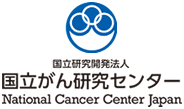
In this seminar you will learn about Progentix, a large open resource in cancer genomics focussing on curation and sharing of somatic copy number variation (CNV) data as well as other resources and research topics of the Theoretical Cytogenetics and Oncogenomics group at the University of Zucrich and teh Swiss Institute of Bioinformatics.
The second part of the presentation will make a case why such resources cannot be sufficient and introduce the approaches shepherded by the Global Alliance for Genomics and Health (GA4GH) Continue reading
Global Alliance for Genomics and Health - Promoting a New Paradigm for Data Discovery in Biomedical Genomics
Seminar at Tohoku University Sendai
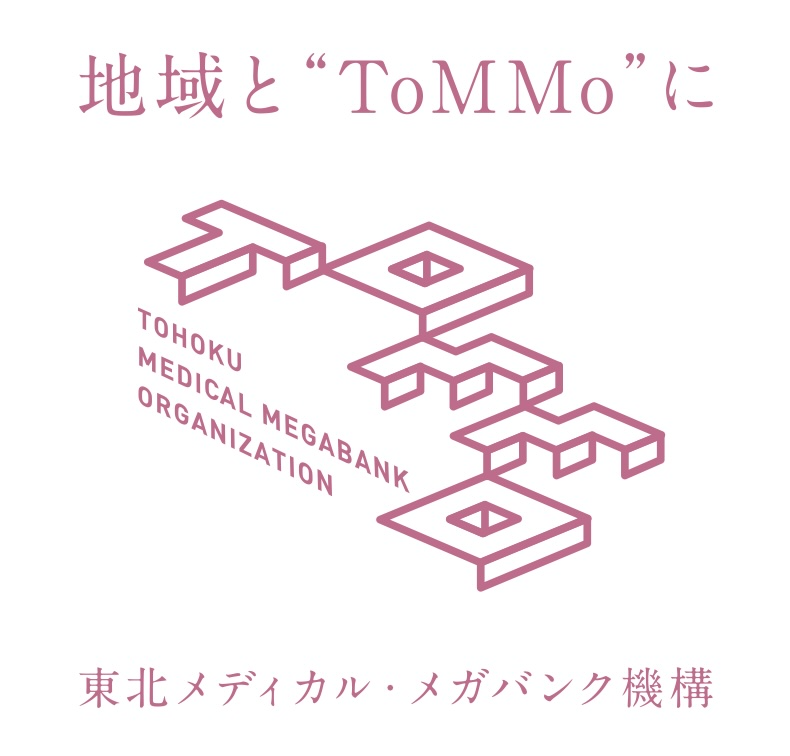
The Global Alliance for Genomics and Health (GA4GH) has developed into a major international organization to address the challenges of data discovery in biomedical genomics. The Beacon standard developed by GA4GH with technical support by the European bioinformatics orgabnization ELIXIR and many international stakeholders has become a default for implementing modern concepts of federated data discovery and access. Continue reading
Beacon Version 2.1.0 Released
A point release of the Beacon Standard
A new Beacon version was released on July 19, 2024. This is a point release of the Beacon Standard and includes following changes:
Continue readingGA4GH Connect April 2024 in Ascona
Spring 2024 GA4GH Connect working meeting co-organized by our group
 We're proud to host the next Spring GA4GH Connect meeting in April 2024 at the
Congressi Stefano Franscini on the Monte Verità in Ascona. This will provide an
excellent opportunity for Swiss genomics and bioinformatics to, well, connect with
the international "genomics and health" community and projects.
We're proud to host the next Spring GA4GH Connect meeting in April 2024 at the
Congressi Stefano Franscini on the Monte Verità in Ascona. This will provide an
excellent opportunity for Swiss genomics and bioinformatics to, well, connect with
the international "genomics and health" community and projects.
cancercelllines.org - a Novel Resource for Genomic Variants in Cancer Cell Lines
DATABASE Article
Rahel Paloots and Michael Baudis¶
Database (Oxford). 2024 Apr 30:2024:baae030. doi: 10.1093/database/baae030¶
bioarXiv preprint (2023-12-13): https://doi.org/10.1101/2023.12.12.571281¶
 Abstract: Cancer cell lines are an important component in biological and medical research, enabling studies of cellular mechanisms as well as the development and testing of pharmaceuticals. Genomic alterations in cancer cell lines are widely studied as models for oncogenetic events and are represented in a wide range of primary resources. We have created a comprehensive, curated knowledge resource - cancercelllines.org - with the aim to enable easy access to genomic profiling data in cancer cell lines, curated from a variety of resources and integrating both copy number and single nucleotide variants (SNVs) data. We have gathered over 5,600 copy number profiles as well as SNV annotations for 16,000 cell lines and provide this data with mappings to the GRCh38 reference genome. Both genomic variations and associated curated metadata can be queried through the GA4GH Beacon v2 API and a graphical user interface with extensive data retrieval enabled using GA4GH data schemas under a permissive licensing scheme.
Abstract: Cancer cell lines are an important component in biological and medical research, enabling studies of cellular mechanisms as well as the development and testing of pharmaceuticals. Genomic alterations in cancer cell lines are widely studied as models for oncogenetic events and are represented in a wide range of primary resources. We have created a comprehensive, curated knowledge resource - cancercelllines.org - with the aim to enable easy access to genomic profiling data in cancer cell lines, curated from a variety of resources and integrating both copy number and single nucleotide variants (SNVs) data. We have gathered over 5,600 copy number profiles as well as SNV annotations for 16,000 cell lines and provide this data with mappings to the GRCh38 reference genome. Both genomic variations and associated curated metadata can be queried through the GA4GH Beacon v2 API and a graphical user interface with extensive data retrieval enabled using GA4GH data schemas under a permissive licensing scheme.
Availability and Implementation: Our resource is publicly available on the web at cancercelllines.org.
Continue readingFederated genomic discoveries: Deploying the GA4GH Beacon protocol
Virtual Seminar
GHGA Lecture Series
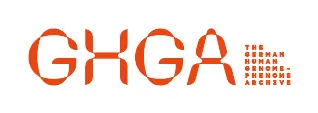 With the ever increasing amount of genomic data produced in the context of research studies, population analyses and medical diagnostics the need for access to genomic information beyond administrative or geographic boundaries has become a matter of eminent importance.
Continue reading
With the ever increasing amount of genomic data produced in the context of research studies, population analyses and medical diagnostics the need for access to genomic information beyond administrative or geographic boundaries has become a matter of eminent importance.
Continue reading
Twelve quick tips for deploying a Beacon
Some hints for Beacon developers & implementers
Lauren A Fromont, Mauricio Moldes, Michael Baudis, Anthony J Brookes, Arcadi Navarro and Jordi Rambla¶
PLoS Comput Biol. 2024 Mar 1;20(3):e1011817.¶
- doi: 10.1371/journal.pcbi.1011817.
- PMID: 38427629
Introduction: In the age of data-driven biomedical research and clinical practice, the sharing of genomic and clinical data for health research and personalized medicine has become an important contribu- tor to improved diagnosis and treatment. From the data owner’s perspective, potential benefits include improved treatments, personalization of healthcare practice, and more effective con- trol of disease proliferation. However, the requirement for high levels of data security to pro- tect sensitive information presents a barrier to data discovery and sharing.
Beacon is designed to enable the benefits of data discovery while minimizing the associated risks...
Continue readingDiscovery Co-Lead Appointed
GA4GH Discovery Work Stream welcomes new Co-Lead Nara Sobreira of Johns Hopkins Medicine
Nara Lygia De Macena Sobreira, associate professor of genetic medicine at Johns Hopkins University School of Medicine, joins the GA4GH Standards Steering Committee as Discovery Work Stream Co-Lead.
Continue readingPhenopacket-tools: Building and validating GA4GH Phenopackets
Bioinformatics tools and examples for working with the Phenopackets standard
Danis D, Jacobsen JOB, Wagner AH, Groza T, Beckwith MA, Rekerle L, Carmody LC, Reese J, Hegde H, Ladewig MS, Seitz B, Munoz-Torres M, Harris NL, Rambla J, Baudis M, Mungall CJ, Haendel MA, Robinson PN. (2023) Phenopacket-tools: Building and validating GA4GH Phenopackets. PLoS One. 18:e0285433.¶
Abstract The Global Alliance for Genomics and Health (GA4GH) is a standards-setting organization that is developing a suite of coordinated standards for genomics. The GA4GH Phenopacket Schema is a standard for sharing disease and phenotype information that characterizes an individual person or biosample. The Phenopacket Schema is flexible and can represent clinical data for any kind of human disease including rare disease, complex disease, and cancer. It also allows consortia or databases to apply additional constraints to ensure uniform data collection for specific goals. We present phenopacket-tools, an open-source Java library and command-line application for construction, conversion, and validation of phenopackets. Phenopacket-tools simplifies construction of phenopackets by providing concise builders, programmatic shortcuts, and predefined building blocks (ontology classes) for concepts such as anatomical organs, age of onset, biospecimen type, and clinical modifiers. Continue reading
Beacon v2 standard highlighted during the GA4GH April Connect 2023
Last month Beacon was present at the GA4GH Connect 2023, the working meeting to advance the GA4GH Roadmap and gather feedback on product development and needs.
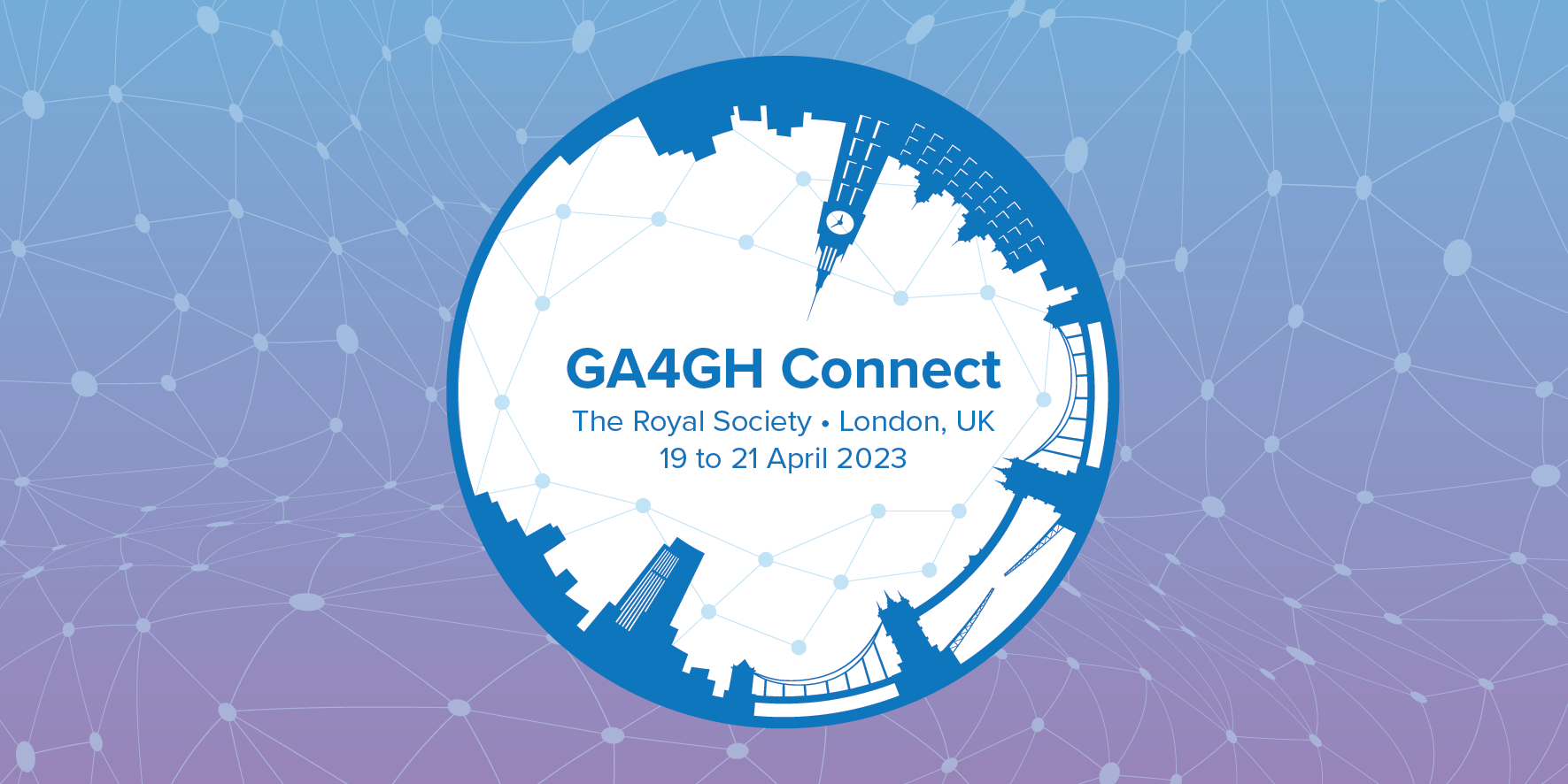
Beacon v2 at the International Congress of Human Genetics with hands-on sessions on Discovery
These Hands-on workshops will take place on February the 26th and 27th, in the framework of the International Congress of Human Genetics (ICHG), that is being held in Cape Town from February 22 – 26.

Beacon v2 - Onboarding Strategies & Feature Examples
Beacon Sessions at GA4GH Connect
Michael Baudis¶
The Beacon Sessions at GA4GH Connect November 2022 targeted the migration of existing and implementation of new v2 Beacons, with emphasis on the "how to get there easily" rather than on all Beacon v2 features. Continue reading
Beacon training course: How to make COVID-19 sensitive data discoverable using Beacons
The online workshop BEACON - How to make sensitive data discoverable will take place on November 2 and 3. The European Genome-phenome Archive (EGA) Beacon Team will provide a special hands-on training session for the BY-COVID partners for "Beaconising" the datasets.
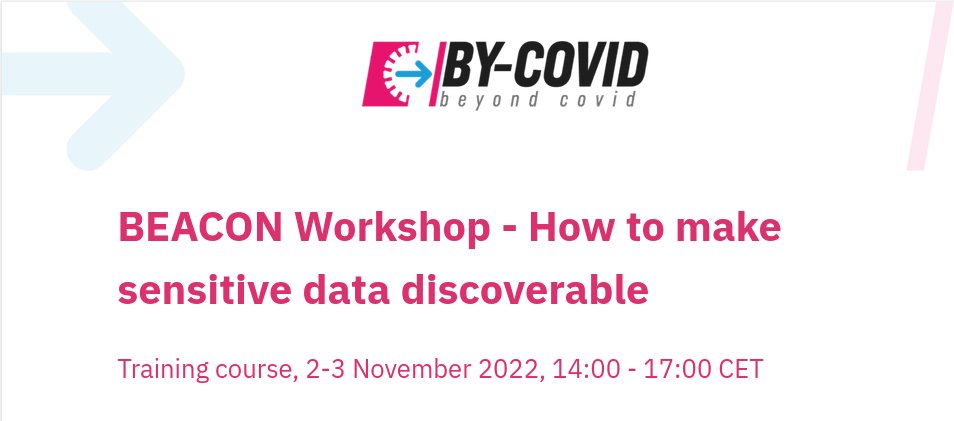
Genomics Data Federation through Global Alliance for Genomics and Health Standards: Development and Implementation of the GA4GH Beacon Protocol
Seminar Yonsei University Medical School Seoul
Michael Baudis¶
In this Seoul meeting presentation Michael introduces the Global Alliance for Genomics and Healt and its involvement in Genomics standards development, followed by a discussion of the Beacon protocol and the role of the Progenetix resouce in its development. Continue reading
Beacon v2 - Feature-rich Implementation of the Genomic Data Discovery Protocol
GA4GH 2022 Plenary Barcelona
Michael Baudis¶
The “Beacon” protocol - developed with support from ELIXIR, the European bioinformatics infrastructure organization, as a standard of the Global Alliance for Genomics and Health (GA4GH) - represents an emerging standard for an “Internet for Genomics”. While the initial version of the protocol served as a widely adopted test bed for the sharing of genomic variants over federated query systems connecting hundreds of internationally distributed resources, the version 2 of the protocol provides a framework for extended, metadata-rich query and response options in both public and restricted federated access scenarios. Continue reading
Beacon reference implementtaion in Bioinformatics
Beacon V2 Reference Implementation: a Toolkit to enable federated sharing of genomic and phenotypic data¶
Manuel Rueda, Roberto Ariosa, Mauricio Moldes, Jordi Rambla¶
The Beacon team at the European Genome-phenome Archive (EGA) presents the Beacon v2 Reference Implementation (B2RI), a set of open-source software tools to enable federated sharing of genomic and phenotypic data.

GA4GH Phenopackets: A Practical Introduction
Phenopackets v2 introduction with practical examples

Ladewig MS, Jacobsen JO, Wagner AH, Danis D, Kassaby BE, Gargano M, Groza T, Baudis M, Steinhaus R, Seelow D, Bechrakis NE, Mungall CJ, Schofield PN, Elemento O, Smith L, McMurry JA, Munoz-Torres M, Haendel MA and Robinson PN¶
Advanced Genetics 2022, 2200016. LINK¶
Abstract The Global Alliance for Genomics and Health (GA4GH) is developing a suite of coordinated standards for genomics for healthcare. The Phenopacket is a new GA4GH standard for sharing disease and phenotype information that characterizes an individual person, linking that individual to detailed phenotypic descriptions, genetic information, diagnoses, and treatments. Continue reading
Beacon v2 will be at the European Conference on Computational Biology with a Workshop on tools and techniques to make sensitive data discoverable
The Workshop "Tools and techniques to make sensitive data discoverable (Use-cases, hands-on session of Beacon implementation)" will take place on September 15th, in the framework of the 21st European Conference on Computational Biology (ECCB). This workshop aims to provide knowledge and hands-on sessions about the discoverability of sensitive genomics and clinical data without jeopardizing the privacy or ownership of such datasets.
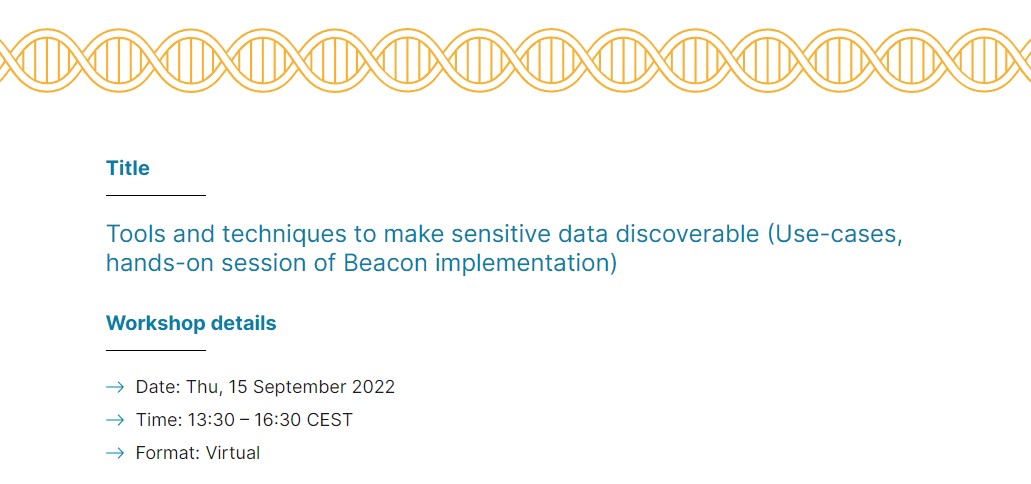
GA4GH 2022 — Beacon v2 standard highlighted at the GA4GH plenary
Jordi Rambla, one of the key Beacon v2 leaders, will present the Beacon v2 Specification in Barcelona for the Global Alliance for Genomics And Health (GA4GH) 10th Plenary Meeting.

The GA4GH Phenopacket schema defines a computable representation of clinical data
Phenopackets v2 publication
Jacobsen JOB, Baudis M, Baynam GS, Beckmann JS, Beltran S, Buske OJ, Callahan TJ, Chute CG, Courtot M, Danis D, Elemento O, Essenwanger A, Freimuth RR, ... , Haendel MA, Robinson PN, The GAGHPMC.¶
Nature Biotechnology. 2022;40:817-820. LINK | PMID:35705716¶
Abstract Despite great strides made in the development and wide acceptance of standards for exchanging structured information about genomic variants, progress in standards for computational phenotype analysis for translational genomics has lagged behind. Phenotypic features (signs, symptoms, laboratory and imaging findings, results of physiological tests, etc.) are of high clinical importance, yet exchanging them in conjunction with genomic variation information is often overlooked or even neglected. Continue reading
Progenetix & BeaconPlus - An open cancer genomics resource on a stack of Beacon code...
ELIXIR All Hands Amsterdam 2022
Michael Baudis¶
Here Michael provides some overview of the multi-year trajectory of the Beacon API development, and how BeaconPlus & Progenetix have been utilized for "implementation driven design".
Continue readingBeacon implementations: Beaconize your genomics data
Beacon v2 Workshop at ELIXIR All Hands
Hosts: Lauren Fromont, Michael Baudis & Jordi Rambla¶
Amsterdam, 7th June 2022 Link to webpage¶
One of the main bottlenecks in human genomics research is the lack of tools for federated discovery of identifiable genomics data that requires tight privacy controls. This problem needs even more attention since genomics data sees an ever greater application in clinical settings, such as for medical diagnostic or prognostic purposes, in rare diseases or cancer. Currently, most of the molecular analyses generated in hospitals are not utilised for further research due to lack of proper tools for an interoperable and ethical sharing of the data. The Beacon project (ELIXIR, see also the Global Alliance in Health and Genomics for the standard) aims to alleviate the problem of genomics data sharing through enabling the search of genomic variants and associated information without jeopardising the privacy of the dataset. This way, any hospital or research entity can choose to 'beaconize' their dataset without compromising its privacy or ownership.
With growing interest from the community in the implementation of the Beacon protocol into resources and workflows, the release 2.0 introduces new features considered important by the community: e.g. queries by entity type, filters, schema versions, and access levels. While both the research and the clinical community recognizes the value of these additions, practical implementation of the Beacon could still be a challenging task, especially for institutions with limited IT resources. The ELIXIR implementation studies (2019-2021; 2022-2024) aim to develop a reference implementation so researchers and clinicians can use it as an example to deploy their own Beacon without needing extensive knowledge on how to build an API.
This workshop has two objectives, to provide participants with:
1- Demos and insights on Beacon implementations. For this objective we will invite early Beacon v2 implementers who provided valuable feedback to the specification and will share their use-cases and experiences: Michael Baudis (Progenetix), Tim Beck (Café Variome), and Carles Hernandez (CNAG-CRG).
2- A training session on how to d eploy a Beacon using the reference implementation. For this objective we will invite members of the European Genome-phenome Archive (Manuel Rueda) who support Beacon deployment in hospitals and clinical institutions and will provide a hands-on session.
Beacon version 2 is a highly expected product in the genomics research and clinical communities. Now that the Beacon community has released a stable version, it is time to provide beacon implementers guidelines and resources to implement or deploy their own Beacons to foster data discovery and data re-use.
Continue readingBeacon v2 and Beacon networks: A "lingua franca" for federated data discovery in biomedical genomics, and beyond
Beacon v2 publication
Rambla J, Baudis M, Ariosa R, Beck T, Fromont LA, Navarro A, Paloots R, Rueda M, Saunders G, Singh B, Spalding JD.¶
Human Mutation. 2022 Mar 17. PMID:35297548¶
Abstract Beacon is a basic data discovery protocol issued by the Global Alliance for Genomics and Health (GA4GH). The main goal addressed by version 1 of the Beacon protocol was to test the feasibility of broadly sharing human genomic data, through providing simple "yes" or "no" responses to queries about the presence of a given variant in datasets hosted by Beacon providers.
Continue readingThe Beacon: a data discovery solution in genomics and health
Beacon v2 Webinar at CINECA
Presenter: Lauren Fromont¶
Personalised medicine is making great progress: facilitating secure access to human data for researchers and clinicians has become key to achieving this. The Beacon aims to promote this by delivering a federated infrastructure for data discovery of human genetic and phenotypic data.
The Beacon is a protocol for sharing information about the presence or absence of a specific mutation in a given dataset. The latest version (v2) of the Beacon also allows to: filter by variables or interest (e.g. gender or age), trigger the data access process, and consult clinical annotation about the variants found, among others. Further, it inserts a brand new feature that was developed for CINECA’s needs: a cohort model, allowing researchers to find appropriate populations (e.g., a group of patients with a specific disease) to help answer their research questions.
Watch the public recording of the presentation here
Continue readingBeacon v2 submitted to GA4GH
Beacon v2 was submitted to the Global Alliance for Genomics and Health and is now available for public review! Our specification is available on Github and several implementations are already available!
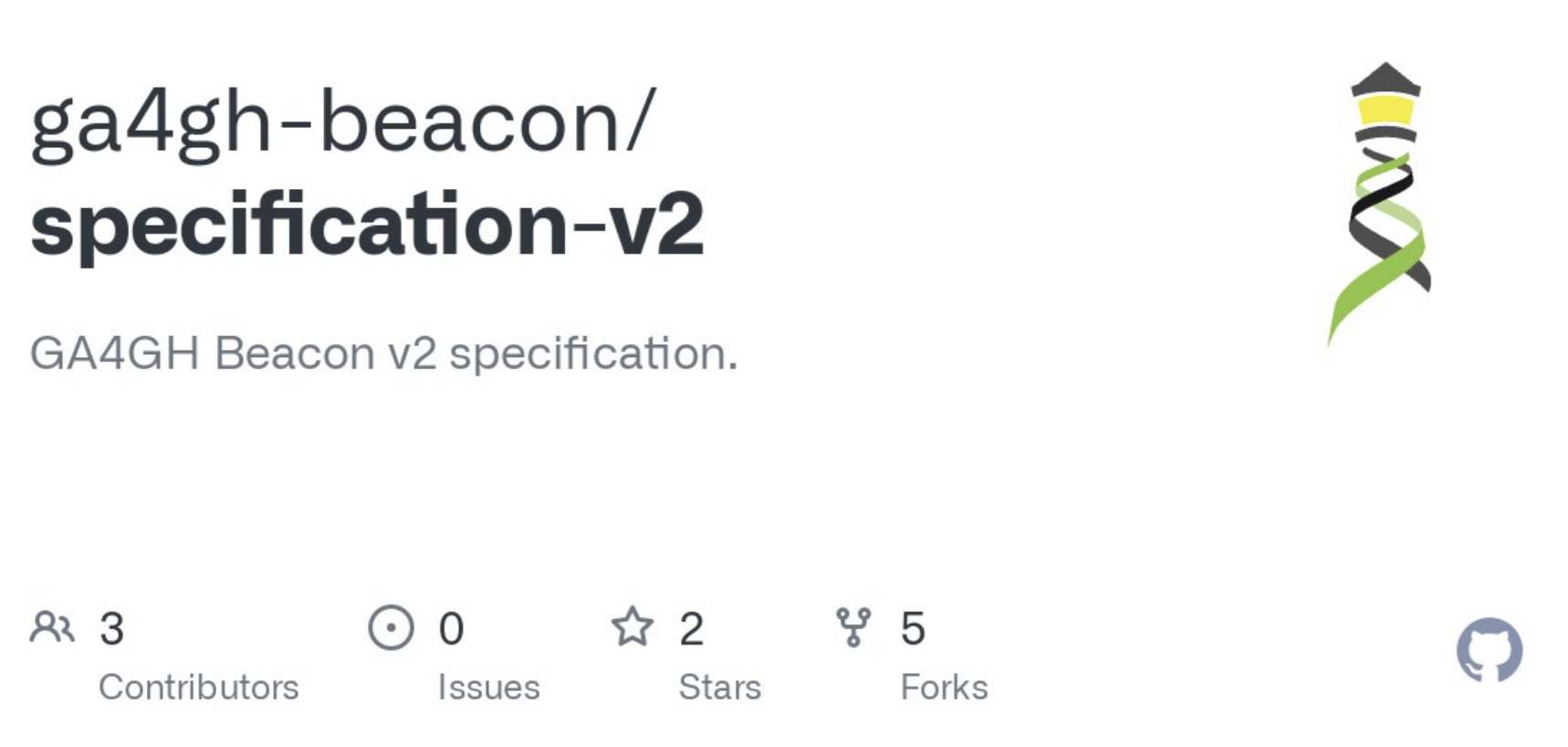
The GA4GH Variation Representation Specification (VRS): a Computational Framework for the Precise Representation and Federated Identification of Molecular Variation.
Alex H. Wagner, Lawrence Babb, Gil Alterovitz, Michael Baudis, Matthew Brush, Daniel L. Cameron, Melissa Cline , Malachi Griffith, Obi L. Griffith, ..., Melissa Konopko, Heidi L. Rehm, Andrew D. Yates, Robert R. Freimuth, Reece K. Hart¶
Wagner, Alex H. et al. Cell Genomics, Volume 1, Issue 2, 100027 doi:10.1016/j.xgen.2021.100027¶
bioRxiv. version 20212021.01.15.426843. (2021-01-15)¶
Note¶
 This article was published as part of a special GA4GH edition of Cell Genomics.
Continue reading
This article was published as part of a special GA4GH edition of Cell Genomics.
Continue reading
International federation of genomic medicine databases using GA4GH standards
Adrian Thorogood, Heidi L. Rehm, Peter Goodhand, Angela J.H. Page, Yann Joly, Michael Baudis, Jordi Rambla, Arcadi Navarro, Tommi H. Nyronen, Mikael Linden, Edward S. Dove, Marc Fiume, Michael Brudno, Melissa S. Cline, Ewan Birney¶
Thorogood, Adrian et al. Cell Genomics, Volume 1, Issue 2, 100032 doi:10.1016/j.xgen.2021.100032¶
Note¶
 This article was published as part of a special GA4GH edition of Cell Genomics.
This article was published as part of a special GA4GH edition of Cell Genomics.
Abstract We promote a shared vision and guide for how and when to federate genomic and health-related data sharing, enabling connections and insights across independent, secure databases. Continue reading
GA4GH: International policies and standards for data sharing across genomic research and healthcare
Heidi L. Rehm, Angela J.H. Page, Lindsay Smith, Jeremy B. Adams, Gil Alterovitz, Lawrence J. Babb, Maxmillian P. Barkley, Michael Baudis, Michael J.S. Beauvais, Tim Beck, Jacques S. Beckmann, Sergi Beltran, David Bernick, Alexander Bernier, James K. Bonfield, Tiffany F. Boughtwood, Guillaume Bourque, Sarion R. Bowers, Anthony J. Brookes, Michael Brudno, Matthew H. Brush, David Bujold, Tony Burdett, Orion J. Buske, Moran N. Cabili , Daniel L. Cameron, Robert J. Carroll, Esmeralda Casas-Silva, Debyani Chakravarty, Bimal P. Chaudhari, Shu Hui Chen, J. Michael Cherry, Justina Chung, Melissa Cline, Hayley L. Clissold, Robert M. Cook-Deegan, Mélanie Courtot, ..., Peter Goodhand, Kathryn North, Ewan Birney¶
Rehm, Heidi L. et al. Cell Genomics, Volume 1, Issue 2, 100029 doi:10.1016/j.xgen.2021.100029¶
Note¶
This article was published as part of a special GA4GH edition of Cell Genomics. Continue reading
A Standardized Format for Federated Genomic Data Exchange
The GA4GH Beacon Protocol Presented at BC2 Basel 2021
Session "Federating computational analyses with GA4GH standards"
Michael Baudis¶

The Progenetix oncogenomic resource in 2021
Article describing the current content & technical status of progenetix.org
Qingyao Huang, Paula Carrio Cordo, Bo Gao, Rahel Paloots, Michael Baudis¶
Database (Oxford). 2021 Jul 17;2021:baab043.¶
- doi: 10.1093/database/baab043.
- PMID: 34272855
- PMCID: PMC8285936.
- bioRxiv. doi: doi.org/10.1101/2021.02.15.428237

Abstract In cancer, copy number aberrations (CNAs) represent a type of nearly ubiquitous and frequently extensive structural genome variations. To disentangle the molecular mechanisms underlying tumorigenesis as well as identify and characterize molecular subtypes, the comparative and meta-analysis of large genomic variant collections can be of immense importance. Over the last decades, cancer genomic profiling projects have resulted in a large amount of somatic genome variation profiles, however segregated in a multitude of individual studies and datasets. The Progenetix project, initiated in 2001, curates individual cancer CNA profiles and associated metadata from published oncogenomic studies and data repositories with the aim to empower integrative analyses spanning all different cancer biologies. Continue reading
Beacon Workshop at ELIXIR AllHands
Chairs: Gary Saunders, Juha Tornroos, Michael Baudis, Dylan Spalding, Lauren Fromont, Jordi Rambla¶
Beacon now stands as the ‘default’ data discovery solution in GA4GH and ELIXIR portfolios, and is increasingly adopted by third-party projects. Beacons become particularly successful through their aggregation in Beacon networks, which provide a way to query many genomic variant resources through a central federation node while receiving aggregated responses all at once. Both Beacon and Beacon Network are part of the 1+MG and B1MG service catalogs and represent core discovery solutions in ELIXIR across the Federated Human Data, Rare Diseases, and human Copy Number Variation Communities.
During this workshop we will discuss:
1) progress of the fruitful collaboration with the GA4GH Beacon community 2) latest developments of the ELIXIR Beacon project including deployment tested instances in clinical and non-clinical settings (via various H2020 projects, GA4GH Driver projects and ELIXIR partners) 3) extensions to the ELIXIR Services specification in order to manage Beacon v2 instances 4) security features of Beacon v2 according to real world needs 5) an extended and improved ELIXIR Beacon Network service.
As a result this workshop will describe how Beacons that are integrated in the ELIXIR Beacon Network Infrastructure can further the contribution and implementation of GA4GH standards, and empower nodes to be part of the federated sensitive human data infrastructure.
Agenda here
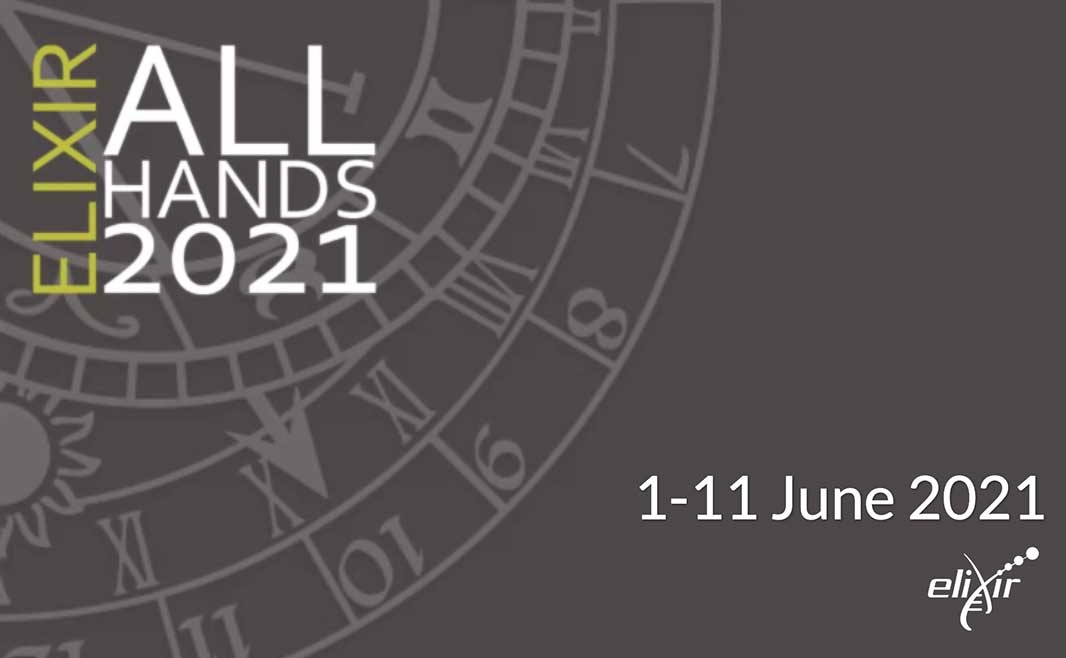
Progenetix, Beacon and GA4GH at RDA
Research Data Alliance - RDA Virtual Plenary 17
Concepts | Status | History | Outlook¶
Michael Baudis¶
Research Data Alliance - RDA Virtual Plenary 17¶
This seminar gives an overview of current state of the Progenetix Beacon project and the overall connection to the Global Alliance for Genomics and Health (GA4GH).
Continue readingGA4GH Connect - Beacon v2 Structural Variants
GA4GH Connect 2021¶
Michael Baudis¶
Beacon v2 Structural Variants [slides]¶
Lauren Fromont & Jordi Rambla¶
Beacon v2 Cohort model [slides]¶
Continue readingHappy 2021 from the Beacon Team
The Beacon Team wishes everybody a happy and healthy 2021! We're excited about our upcoming Beacon v2, expected to be finalized later this year.
Continue readingGA4GH Beacon v2 at GA4GH Plenary
Evolving Reference Standard for Genomic Data Exchange
GA4GH 8th Plenary¶
Gary Saunders, Jordi Rambla de Argila, Anthony Brookes, Juha Törnroos and Michael Baudis¶
For the ELIXIR Beacon project, GA4GH Discovery work stream and the international network of Beacon API developers¶
The Beacon driver project was one of the earliest initiatives of the Global Alliance for Genomics and Health with the Beacon v1.0 API as first approved GA4GH standard. Version 2 of the protocol is slated to provide fundamental changes, towards a Internet of Genomics foundational standard: * requests beyond genomic variants ("filters") * payload responses, secured through open AAI * aligning w/ GA4GH standards (Phenopackets, VRS, DUO...) through SchemaBlocks {S}[B] * Working with international partners on deployment of advanced implementations
Continue readingProgenetix - A cancer genomics reference resource around GA4GH standards
GA4GH 8th Plenary¶
Michael Baudis¶
The Progenetix oncogenomics resource provides sample-specific cancer genome profiling data and biomedical annotations as well as provenance data from cancer studies. Especially through currently 113322 curated genomic copy number number (CNV) profiles from 1600 individual studies representing over 500 cancer types (NCIt), Progenetix empowers aggregate and comparative analyses which vastly exceed individual studies or single diagnostic concepts.
Continue readingCNV Beacon at Biohackathon Europe
For the Biohackathon Europe (Nov 18-22), the hCNV project submitted a proposal which was accepted for the event near Paris.
Continue readingGA4GH 2019 — Beacon v2: Towards a modular Beacon protocol empowering clinical use
Poster abstract for the GA4GH Plenary, Boston 2019¶
The Beacon Project is a Global Alliance for Genomics and Health (GA4GH) initiative for the federated discovery of genomic data in biomedical research and clinical applications. Originally implemented as a tool reporting the existence of Single Nucleotide Polymorphisms (SNP) in aggregated genomic data collections, the protocol has evolved towards more complex applications with increased functionality. Implementations of the current Beacon API enable the search for structural variants (e.g. deletions and duplications) and return richer responses (e.g. variant metadata and call counts).
Continue readingBarcelona Goes Zurich - Beacon Code Alignment Workshop
The Zurich meeting is intended to align the current development version of the Beacon API and the Beacon+ driver, and to improve the documentation structure of the Beacon project.
In another part of the 2-days meeting we will explore further the concept and possible implementation of "Evidence Beacons", together with developers from the SVIP project.
The tentative agenda for the meeting is linked below.
Continue readingELIXIR Beacons at ELIXIR All Hands 2019 Workshop
Purpose of this workshop:¶
- Update on GA4GH Beacon API and Beacon Network developments
- Demonstrate ELIXIR Beacon implementation of new API and Network features
- Present the future vision for Beacons - Beacon 2.0
Presentations¶
- Michael Baudis: ELIXIR and GA4GH in Beacon development
- Juha Törnroos: ELIXIR Beacon Network
- Mikael Linden and Dominik F. Bucik: AAI and Affiliation Assignment
Please see the link below for more information.
Continue readingBeacons Hackathon Stockholm
On March 7, Beacon team members from ELIXIR and DNAstack will meet at the SciLife Center Stockholm for Face-to-face meeting and Hackathon.
Continue readingPlant Beacons Hackathon Bordeaux
The hackaton took place the 2019-02-28 in the center of Bordeaux in the room "RE" of the former Law Faculty of the University of Bordeaux.
Continue readingFederated discovery and sharing of genomic data using Beacons
Miroslav Cupak , Stephen Keenan , Jordi Rambla , Sabela de la Torre , Stephanie Dyke , Anthony Brookes , Knox Carey , David Lloyd , Peter Goodhand , Maximilian Haeussler , Michael Baudis , Heinz Stockinger , Lena Dolman , Ilkka Lappalainen , Juha Törnroos , Mikael Linden , John Spalding , Saif Ur-Rehman , Angela Page , Paul Flicek , Susheel Varma , Gary Saunders , Serena Scollen , Stephen Sherry , David Haussler , Beacon Project Team¶
Nat Biotechnol (2019), accepted 2019-01-23¶
Abstract The Beacon Project (github.com/ga4gh-beacon/) is a GA4GH initiative that is developing an open specification for genetic variation discovery and sharing. The project is demonstrating the willingness of international organizations to work together to define standards for, and actively engage in, genomic data sharing. In the two years since the project’s inception, over 90 Beacons have been lit by 35 organizations serving over 200 datasets. Continue reading
